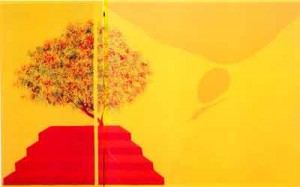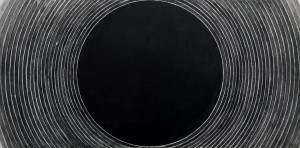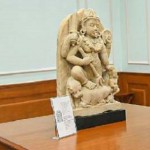I went to Japan in cherry blossom season. That blink-and-miss time of the year, when the universe is coloured pink-and-white before the flowers sadly float away from the trees, reminding us of the impermanence of life and its fragile joys. Filled with the delicate scent of the blooms, I walked into the drawing room of the Indian embassy in Tokyo, and confronted a dramatically opposite landscape – a canvas by the artist Jagdish Swaminathan, from his celebrated bird-tree-mountain painting series.
Beginning in the 1960s and executed over two decades, the series juxtaposed elements from nature on layers of bold reds, sunshine yellows and quiet greens to create mysterious and magical geometrical spaces.

This work, like several more in the collection of the Ministry of External Affairs was purchased by its Objects d’art committee. The committee was set up some time in the 1950s by the diplomat Badruddin Tyabji for showcasing the best of Indian art and craft in the country’s embassies across the globe.
Badrudin Tyabji’s daughter Laila, founder president of Dastkar, an organisation working with crafts persons, says she admired every work of art her parents bought for the MEA. From Jamini Roy’s mother and child figures, to N.S. Bendre’s serene depictions of the countryside. But as a small child in Jakarta she was fascinated by a K.H. Ara’s painting of a fisherwoman. It was “an almost abstract depiction of her with a basket, in shades of dull grey and purple and dusty pink.”
Ara, best known for his evocative still life studies was a member of the Progressive Artists’ Group set up in Bombay in 1947 by Francis Newton Souza with Sadanand Bakre, H.A. Gade, M.F. Husain and S.H. Raza. They were part of an artists’ movement which was rejecting past styles and conventions to frame a more authentic, non-romantic response to a rapidly changing world. It was just what Nehru wanted.
That’s why the Objects d’art committee’s shopping list for several decades after India’s independence continued to mirror India’s first prime ministers choice of modernism, as the most appropriate vehicle to represent the young nation’s future agendas. One which made him invite the Swiss-French architect Le Corbusier to design the new city of Chandigarh.
But like Nehru, the search for a new language of expression, did not alter the identity of the artists experimenting with modernism. It remained firmly rooted in Indian culture, traditions and history.
Swaminathan’s iconography was drawn from the folk and tribal idioms of Kutch, Kinnaur and Bastar, Pahari miniatures and Hindu mythology, Husain’s early figures were inspired by the sculptures of the Gupta period, while Tyeb Mehta’s deeply etched images of pain were drawn from his memories of Partition.
Soon the canvases, water colours, line drawings, prints and sculptures of the modern artists, followed by the contemporaries, were visible round the world in the country’s missions. The MEA collection in a small yet significant way began to reflect new trends in Indian art and craft. Whether it was the strong emergence of the figure in the works of Ghulam Mohammed Sheikh, Bhupen Khakhar, Bikash Bhattacharjee, Arpita Singh and others. Or a rediscovery of the master weaver and craftsman following the Festivals of India in the 1980s.
The Object d’art committee combines representatives of the Ministry including the spouse of the serving foreign secretary, and experts from the field of art and crafts. Usually, MEA officials are known to follow the lead of their advisors. An exception was foreign secretary M.K. Rasgotra who actively participated in the selection process, and would often embarrass his junior colleagues by wistfully wondering, “Why don’t we get some really good nudes?”
But the nudes that did find their way into the MEA collection were routinely relocated. A painting in the Indian mission in Iran had to be sent back for fear of offending the local staff on the premises. While a beautiful nude of a young woman by M.F. Husain hanging in the office of the foreign minister had to be hurriedly taken down after one of its occupants complained he found the painting vulgar.
And it was not just the nudes that often made the top brass uneasy.
When Jaswant Singh, India’s foreign minister from 1998-2002 came face to face with one of S.H. Raza’s iconic ‘Bindu’ paintings, he was aghast. The black circular void for the artist, is a centre of silence and meditation, a source of energy, the very origin of life; for Singh it symbolised shunya or zero, emptiness and death. The painting had to be instantly removed from his presence.

Similarly, when Karan Singh came to Washington as India’s envoy in 1989, the embassy was in possession of a large number of ancient sculptures of deities from the Hindu pantheon. These had been borrowed by his predecessor P.K. Kaul from the National Museum in New Delhi, to fill the vast empty rooms of the mission. But before the crates were opened, the government had changed, Rajiv Gandhi had been replaced by V.P. Singh in Delhi, and P.K. Kaul returned to India.
Lalit Mansingh, who was posted in the embassy at the time, recalls waiting patiently for the next ambassador to take charge before he could finally install the sculptures. But Karan Singh flatly refused to allow it claiming that “Khandit murti ashubh hoti hain.” The ‘damaged and therefore inauspicious figures,’ went back into their boxes. Finally Abid Hussain who followed Karan Singh to Washington picked out a large statue of Ganesh, the most lovable, easygoing and secular of Hindu Gods and placed it in the lobby of the embassy.
Till the 1990s, for many artists and students the Indian embassy served as a home away from home. Salman Haider, who was briefly our high commissioner in Britain believes that the India House in London designed by the British architect Herbert Baker has an almost spiritual setting. He believes it has inspired many painters to use it as a studio, hold exhibitions. M.F. Husain even stored his unsold works in the building.
He also draws attention to the superb collection of portraits in the MEA, some of them possessing great artistic and historical value. Including those of Rabindranath Tagore, Lala Lajpat Rai and Jawaharlal Nehru.
Over time as the collection grew, so did its losses. The first to notice this was Lalit Mansingh. “Our embassies in Eastern Europe were often located in palaces of former royals and furnished with antique furniture and carpets. On my visits there, I began to observe that many of these priceless pieces were being substituted by poor quality fakes.” However, it was only after he discovered that a set of valuable dancing figures in Washington had been replaced by plaster of Paris models that he insisted on an inventory of the MEA’s collection.
Soon afterwards, he found an unlisted painting in the Ministry’s storeroom. Damaged and unsigned, its provenance remained a mystery till a hint of restoration revealed it to be a work by Akbar Padamsee. But by then, several masterpieces had already disappeared.
Shikha Trivedy is a journalist and Features Editor for NDTV 24×7.
This article was exclusively written for Gateway House: Indian Council on Global Relations. You can read more exclusive content here.
For interview requests with the author, or for permission to republish, please contact outreach@gatewayhouse.in.
© Copyright 2016 Gateway House: Indian Council on Global Relations. All rights reserved. Any unauthorized copying or reproduction is strictly prohibited


